Contra Deraa
Having, in my earlier three pieces on the Bey of Deraa, the intriguing cacti photograph* of T.E. Lawrence, and the Deraa misrepresentations of James, offered new evidence for the truth of the Deraa incident and also defended Lawrence against wild charges of its falsity, I must now "switch benches" and proceed to advance the prosecution case, offering arguments, many based on newly discovered evidence, against the truth of the incident. (1) These essays taken together thus accurately reflect the development of one open-minded Lawrence researcher over the three-year course of his study. I invite readers, too, however entrenched on one side of the debate or the other, to appreciate thereby the deep ambiguity of the question.
What follows is a two-part presentation of the case against Deraa, consisting firstly of specific arguments against it, and secondly of probable influences in its genesis, if indeed it was an invention. The case is by no means conclusive, merely tentative.
Possible Evidence for a Deraa Fiction
1. Lawrence's three-day Azrak-Akaba ride. Lawrence's speedy ride south from Azrak to Akaba, covering nearly 300 miles in three-and-ahalf days, November 23 — 26, 1917, and completed within a week of his alleged torture in Deraa on November 20, casts doubt on the reality of that incident. During the ride, he spent an average of nearly twenty hours a day in the saddle and, as he himself relates in Chapter 81 of Seven Pillars of Wisdom, fell off his camel a number of times. Had he sustained many lacerations and two bayonet wounds at Deraa just days before, the constant motion and those falls would certainly have stretched his skin and thus reopened any such wounds. Continuing his long ride with bleeding wounds would have been next to impossible.
читать дальше Lawrence's exhaustion from the ride alone could, moreover, easily account for the much later testimony of certain comrades (see Mack, p. 233) who recalled him, or thought they recalled him, appearing "shaken" and "pale" upon his arrival in Akaba. As evidence for the Deraa incident, such testimony is therefore doubly weak.
2. Hogarth's November 29 letter, and Dawnay's November 30 report. Hogarth's statement in his letter home to his wife on November 29, 1917, alluding to an unspecified mission by Lawrence (see Essay 7, point 13) in late November, could be considered an allusion to a Hauran reconnaissance ride (as this writer long thought), until its temporal references are evaluated in light of an Arab Bureau report of November 30. Hogarth specifically writes, based on information probably two weeks old, that he knows where Lawrence is "now" and whither he is "about to go." These words agree better with Dawnay's November 30 report stating that "LAWRENCE himself has been until recently at AZRACK, but it is believed that he intends to leave today (30th November) for JAUF" (Wingate Papers, 147/2/45, Durham).

Now, Jauf lies to the southeast of Azrak and Lawrence himself refers
to such a planned visit in his December letter home, confirming the
interest (in raising the Rualla tribe?). In short, it seems very unlikely
that Hogarth's statement referred to a Hauran ride.


3. Lawrence's letter home of December 14, 1917. In this letter, Lawrence mentions that he "stayed there [at Azrakj for ten days or so" in mid-November. Such a time-table flatly contradicts that necessary for any Hauran-Deraa reconnaissance ride. The ride would have taken Lawrence five full days, judging from his two Seven Pillars accounts (1922 and 1926) of its stages: Um el Jimal, Umtaiye, Ghazale, Miskin, Sheikh Saad, Tafas, Tell Arar, Mezerib, Ataman (Uthman), Deraa, Nisib, and finally Azrak again, a total of some 200 miles. (2) The ride would therefore have left only five days before it, November 12 — 16, for his Azrak sojourn. His December 1917 reference to the "ten days" spent at Azrak is perhaps explicable as a deliberate withholding of the unpleasant (Deraa) truth from his family, but it cannot be uncritically accepted as such. Coupled with other evidence, the reference is disturbing, particularly because of its specificity. Lawrence does not merely write "some" or "several," but more explicitly "ten days or so." If, in fact, he remained at Azrak throughout that period, he would indeed have spent eleven nights there, November 12 — 22. A subsequent temporal reference in the same letter to "a few days motoring" is demonstrably correct, referring to his three-day participation in a later reconnaissance up Wadi Itm and Hawara.
Desmond Stewart, in his 1977 Lawrence work, first cited the "ten days" reference as important evidence against the Deraa incident (the letter had been quietly published in the 1954 Home Letters volume), but it has apparently been wrongly ignored by Lawrence scholars since, rightly wary of Stewart's own fantastic alternative scenario.
A further reference in Lawrence's December 14 letter home, to "acquaintances from Rabegh to Deraa," which might, on the other hand, seem to support the notion of a Deraa reconnaissance, could easily be a geographical note, for his parents' sake, of the nearest town to Azrak (itself probably not on many maps). The reference could also have been prompted by the visits of Syrian refugees to Azrak that November. It is not strong evidence for a Deraa reconnaissance, much less for Lawrence's capture and torture there.
4. Lawrence's December 15, 1917, trans-Jordan geography report. This report, hitherto unpublished (and only discovered by the present writer in the autumn of 1995), again suggests, now by omission, that Lawrence never went on the mid-November Hauran reconnaissance ride which he relates in Seven Pillars as having precipitated his Deraa capture. The report describes, for the benefit of British armoured car units, the terrain throughout trans-Jordan, but the Hauran region north of Deraa is not described, nor is Deraa itself. The closest area described lies a few miles southwest of it. To quote from the report:
"Major Lawrence has furnished the following information. Begins.- Pilgrim Route from AMMAN to DERAA is not passable to Cars throughout. A detour into W. EL HARITH would be involved, owing to hills on each side of DHULEIL — KHIRBET EL SUMRA and so by GHADIR ABU SAWANA to IFDEIN (MAFRAK). In winter a Ford could make this detour but not an Armoured Car. From MAFRAK to BUEIB DERAAT possible in winter by leaving Pilgrim route on right and working along watershed from GHADIR EL ABYAD. During rain and for some days afterwards route from BUEIB DERAA to DERAA unpassable. Without some days work by gang of 50 men, Pilgrim route from AMMAN to KUTRANE not possible. Path to bridge 14 [Tell el Shehab] is down a cliff 250 feet high from South. Across an unapproachable bridge and through a railway cutting from North. Bridge not negotiable by Cars as it is only a skeleton of girders.
Bridge 15 is in a more open country but except with tackle is not practicable for Cars. Except in prolonged frost or in the fine season, plain leading up to W. MEDDAN from South and North in each case impossible for Cars." (Durham, Sudan Archive, Wingate Papers, 147/3/87).
Now, all of the places named here were visited or passed by Lawrence on his two railway raids of June and early November 1917 to the south and west of Deraa, respectively. The only hint of topographical knowledge from north of Deraa or the rim of the Yarmuk Valley is Lawrence's single reference to the "plain leading up to W. MEDDAN [the Yarmuk Valley) from South and North... impossible for Cars." But this is slender evidence, for the information could well have derived from an informant (Abd el Kadir? See Seven Pillars).
The original request for information, to which Lawrence's telegram report is the reply, has so far proven elusive. However, it appears to have inquired either of the Pilgrim Route (which begins outside Damascus), or of any topographical knowledge Lawrence gleaned in November 1917.

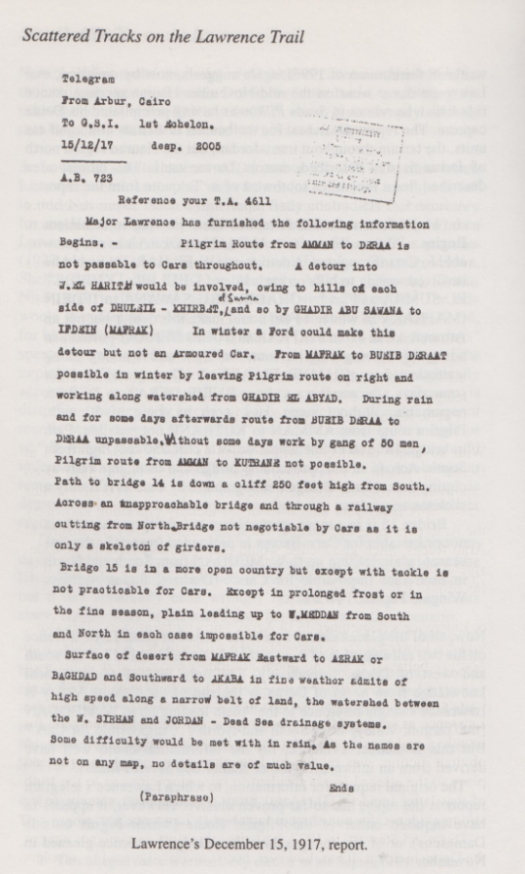
If the Hauran reconnaissance ride related in Seven Pillars was a fiction, why would Lawrence have included it as background for the more specific Deraa episode? The answer would be that he probably had indeed considered, in mid-November 1917, undertaking precisely such a reconnaissance mission, and naturally remembered that plan when imagining his Deraa scenario after the war.
5. A June 5, 1918, intelligence report by Colonel Joyce describing Arab personnel at Deraa. This report, again previously unpublished, describes the composition of the Deraa staff in a manner at odds with Lawrence's later statement that his capture and escape had been "hushed up" there. Joyce notes:
"Satisfactory letters have been received by Sherif Feisal from DERAA, showing that the personnel in most of the departments, including the telegraph, are Arabs, and are available to be utilised when required. Abdel Hady el Sulah, formerly chief telegraph clerk at DERAA, is now in Sherif Feisal's camp." (Public Record Office, WO 158/634, III, 138A).
With so many disaffected Arabs manning the Turkish facilities at Deraa, it would seem unlikely that Lawrence could have been captured, interrogated, tortured, and then have escaped (search parties presumably being sent out) without his identity becoming known by the Arab personnel and thence, via secret messages, by the insurgent Arab forces. Such knowledge would then probably have been widespread by the end of the war. Yet no known Arab sources attest to it (as Mousa has repeatedly written).
6. Lawrence's September 1918 Azrak imprisonment story. This story, told by Lawrence in September 1918 to his driver S.C. Rolls, who gullibly believed it and no doubt accurately recounted it in his own 1937 work Steel Chariots in the Desert (p. 249), depicts Lawrence as having once been imprisoned in a well or cellar at Azrak. Rolls quotes Lawrence as saying: "Once I was kept a prisoner in that dungeon for months," and specifically referring to his "scratchings." The story, an obvious fiction, was related by Lawrence near enough in time and place to the alleged Deraa incident to raise suspicions as to the truth of that latter incident. The Azrak story would appear, namely, to be strong evidence for punishment fantasies in Lawrence's mind.
Desmond Stewart, in 1977, first cited this story as evidence against the Deraa incident. It has, however, been unwisely ignored by scholars since then who, as mentioned in point 3 above, understandably dismissed the more fantastic elements in Stewart's scenario.

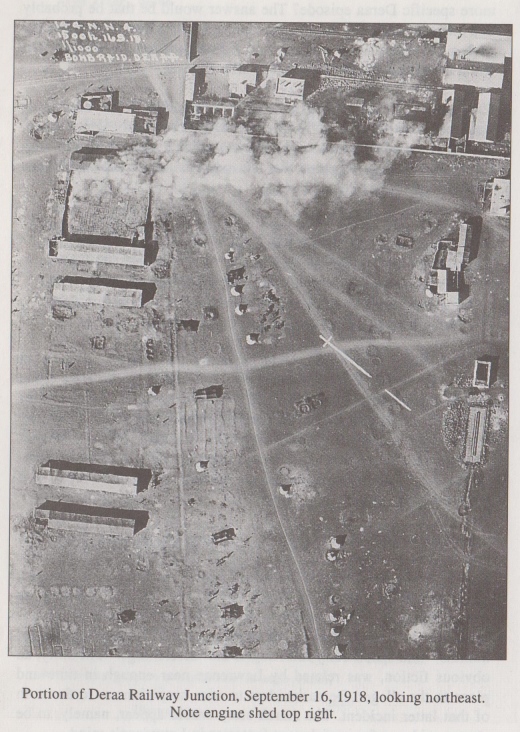

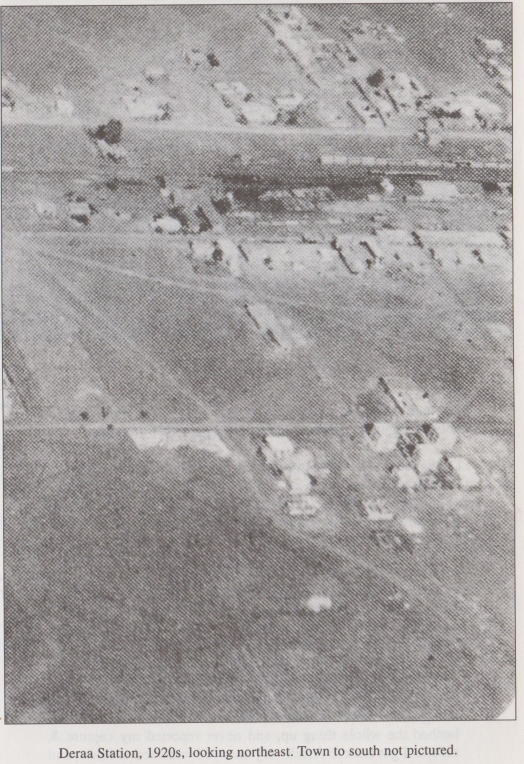

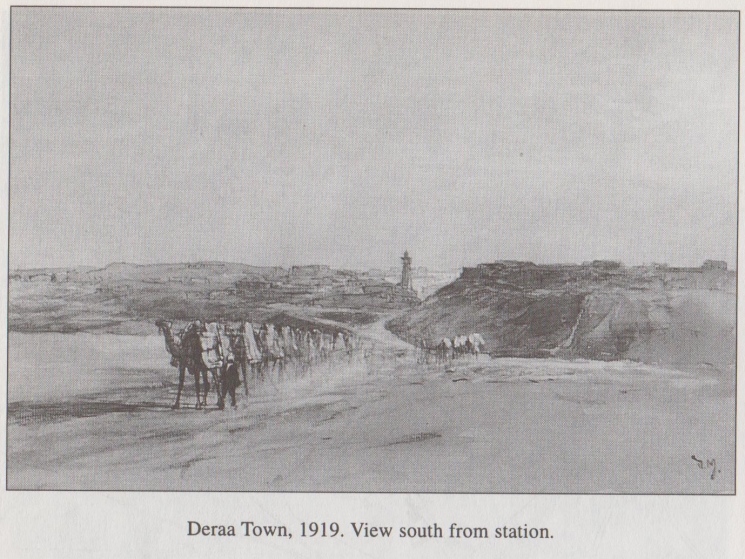
7. Lawrence's 1919 letter to Major Stirling. The single strongest piece of evidence for the Deraa incident is probably Lawrence's June 28, 1919, letter to Stirling (Letters, Brown). In it, for the first time, Lawrence briefly outlined the incident. The relevant eight sentences of the much longer letter read:
"I went in to Deraa in disguise to spy out the defenses, was caught, and identified by Hajim Bey the Governor by virtue of Abd el Kadir's descriptions of me. (I learnt all about his treachery from Hajim's conversation, and from my guards.) Hajim was an ardent paederast and took a fancy to me. So he kept me under guard till night, and then tried to have me. I was unwilling, and prevailed after some difficulty. Hajim sent me to the hospital, and I escaped before dawn, being not as hurt as he thought. He was so ashamed of the muddle he had made that he hushed the whole thing up, and never reported my capture & escape. I got back to Azrak very annoyed with Abd el Kadir, and rode down to Akaba." (Humanities Research Center)

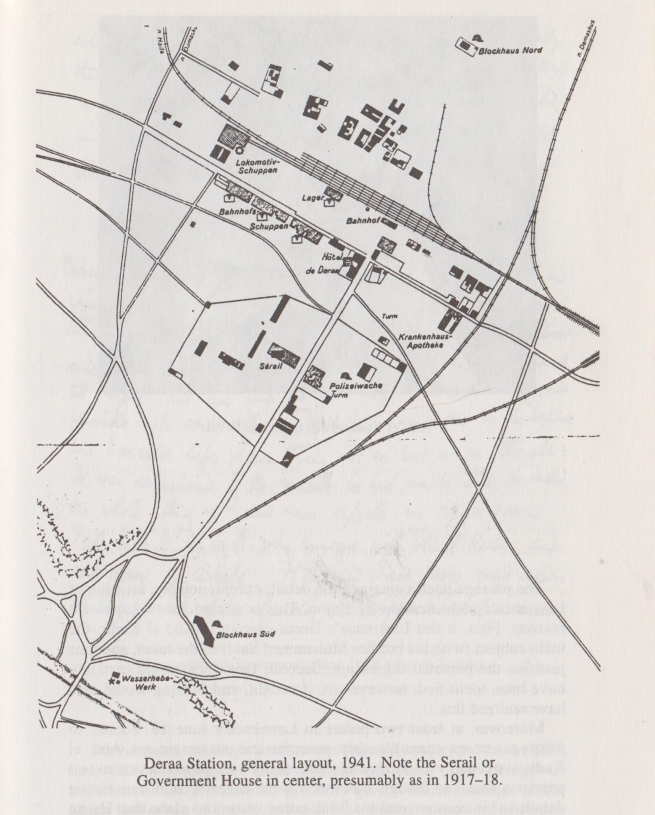

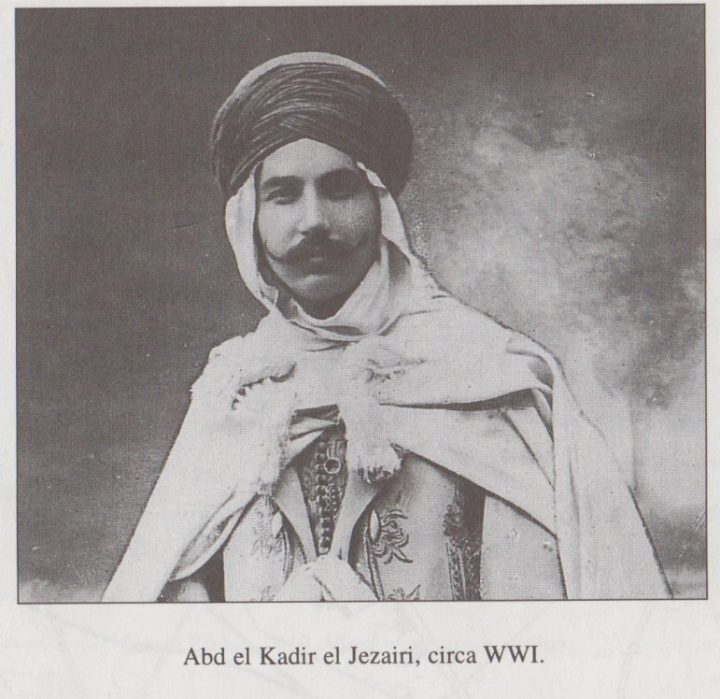
The passage itself contains little detail, except, notably, mention of Lawrence's identification by Hajim. This is related for two apparent reasons. First, it ties Lawrence's Deraa capture to Abd el Kadir, the main subject (with his brother Mohammed Said) of the letter, and thus justifies the personal digression. Second, Lawrence would certainly have been identified, however so, if caught, and Stirling would also have realized this.
Moreover, at least two points in Lawrence's June 1919 letter to Stirling are questionable: his parenthetical statement on Abd el Kadir's treachery in betraying him, oddly interposed between two previous lines as though Lawrence were eager to add convincing details to his account; and his final, rather gratuitous claim that Hajim had "hushed up" the matter, which is something Lawrence could not possibly have known, though it does conveniently explain (or does it?) the complete lack of intelligence about such an incident.

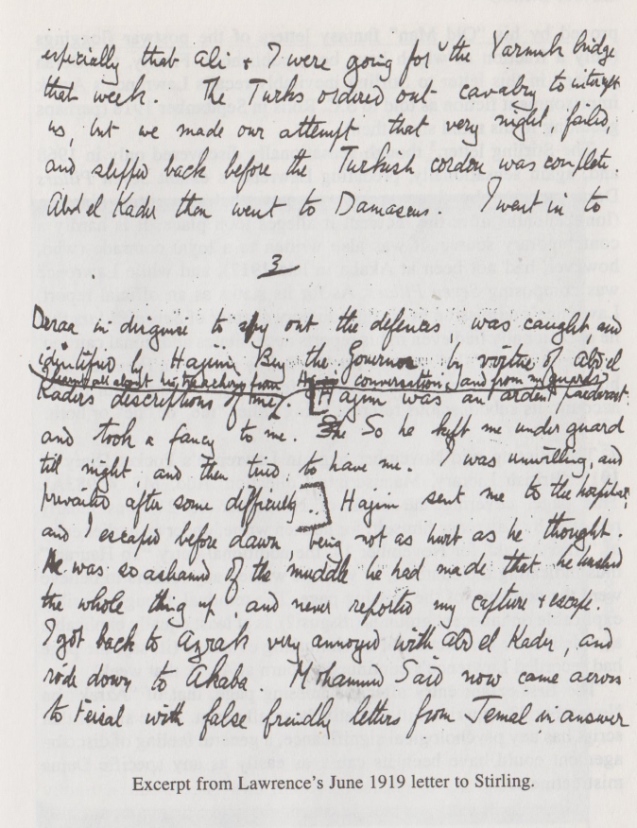
Furthermore, although most of the Deraa passage (and Lawrence's later such statements to others) might still seem "convincing," no experienced detective would probably give it much credence alone. Many stories sound convincing until hard evidence proves them false. And if Lawrence fabricated the Deraa incident for Seven Pillars, he would certainly also have prepared and maintained that fabrication elsewhere. That he could indeed compose elaborate written fictions is proved by his "Old Man" fantasy letters of the postwar floggings (only a fraction of which have been published). Finally, the Deraa passage in this letter to Stirling inevitably recalls Lawrence's Azrak imprisonment fiction as told to S.C. Rolls in September 1918 (perhaps gestating in his mind since then).
The Stirling letter (3), though sensationally discovered only in 1968 and, again sensationally, predating Lawrence's extant Seven Pillars Deraa account by three years, was nevertheless written nineteen (long) months after the incident it alleges took place. It is hardly a contemporary source. It was also written to a loyal comrade (who, however, had not been at Akaba in late 1917), and while Lawrence was composing Seven Pillars. As for its status as an official report, Lawrence's admission in his introductory chapter of Seven Pillars that he occasionally lied even in his reports necessitates additional caution.
The original "She" written for "So he" is perhaps a Freudian slip, but, if so, could be interpreted both for or against the truth of the account, its subconscious referent being either "me" or "he" or both.
8. The missing mid-November page in Lawrence's Pocket Diary of 1917 (British Library, Manuscripts Collection, Add. MS. 45983A). This page, covering the week of November 15 — 21, was clearly removed by Lawrence himself, for he then wrote, under an earlier entry of "Kasr Azrak" for November 14, the additional entry "To Hauran," thus indicating the contents, or what he wished any readers to believe were the contents, of the missing page. The removal, though possibly explicable on innocent grounds (disgust?), is at least equally explicable as a deliberate destruction of incriminating evidence (if, say, the page had recorded Lawrence's continued sojourn at Azrak that week).
The first extant entry after the missing page, that of "Azrak" on November 22, is written in a relatively small sсript. If the size of that sсript has any psychological significance, a general feeling of discouragement could have been its cause as easily as any specific Deraa mistreatment.

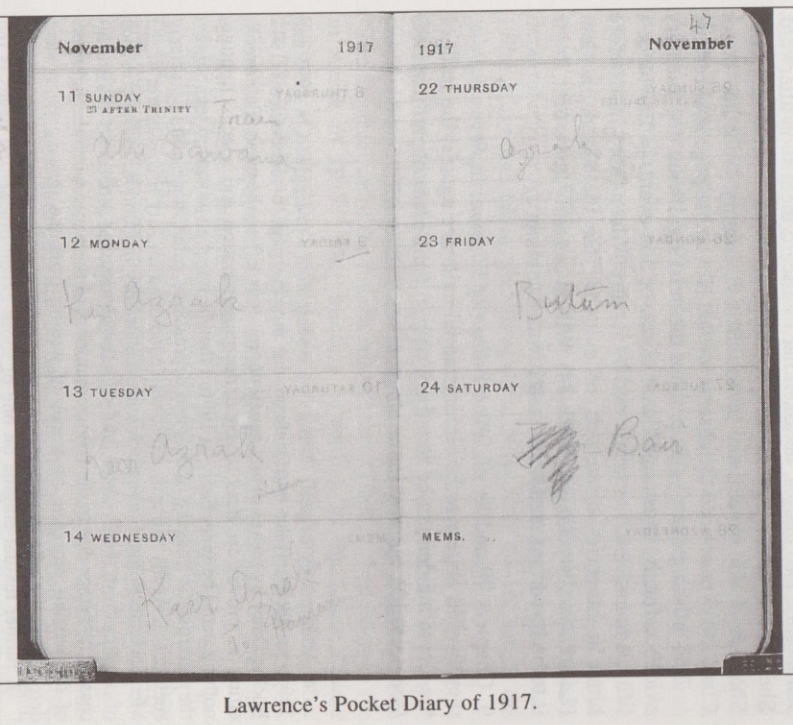
In 1926, Charlotte Shaw asked Lawrence for his two war diaries and his journals. He sent her the diaries on June 11 (British Library, Manuscripts Collection, Add.MS.45903, fo. 96). By then, she had already critiqued the manuscript of Seven Pillars and committed herself to its greatness. The work itself was in the very process of being printed. Lawrence had certainly removed the diary page by then. In sending the two diaries, he asked her to discard them soon afterward. She did not do so, but did keep them private. After her death, G.B. Shaw in 1945 gave them to the British Library. Whether he or Charlotte ever noticed the absence of that November page is uncertain.
This missing diary page, perhaps the most significant documentary evidence for the most significant event, or non-event, in Lawrence's life, (4) is not so much as mentioned by Jeremy Wilson (nor Mack before him) in his brief discussion of evidence for the Deraa incident (Lawrence of Arabia, pp. 1083 — 84). Wilson certainly knew of it, knew it to be important, and knew that it was troubling.
1. It seems correct here to note that none of the evidence and arguments offered in this or the following essay came via responses by others in the field to the brief Deraa discussion in my Meinertzhagen book. In fact, there has been no response, which in itself is quite revealing.
2. This alleged route is remarkably similar to his September 1918 one.
3. Lawrence's March 26, 1924, letter to Charlotte Shaw (Lerrers, Brown), also discovered by Knightley and Simpson only in 1968 and likewise regarded by many since then as strong evidence for the Deraa incident, seems to me questionable on at least two counts. First, Lawrence's passage on Deraa begins on a somewhat false note: "About that night. I shouldn't tell you...," and then, of course, he does just that. Second, the passage ends with a vividly realistic fantasy: "Consider wandering among the decent ghosts hereafter, crying 'Unclean, unclean!'" This is not good evidence for the reality of the incident in question.
4. Attempts by myself, during two research trips to England in 1993 and 1995, to decipher the entries from the missing page of Lawrence's 1917 Pocket Diary by means of any pencil depressions left on the pages once bracketting it, proved fruitless. Even under magnification and special lighting, nothing could be seen. Early in 1996, I then heard of an advanced technology, the electrostatic imaging of indented depressions, often successful in precisely such cases. At my request, a test was conducted on July 9 by experts of the Metropolitan Police Forensic Science Laboratory in London, in the presence of curators from the British Library. Unfortunately, the procedure was unsuccessful. Whether due to the relative hardness of the paper, or to the lightness of the writing pressure, no traces of writing from the missing page were detected on the adjacent pages.
A further textual enigma on one of those extant bracketting pages is the name of "Salem" written under the date of November 13 and after the main entry of "Kasr Azrak." Lawrence first wrote it carefully, with serifs on the tiny capital "S," then crossed it out, as though indicating a death. One naturally recalls Lawrence's elegiac Seven Pillars dedicatory poem "To S.A." (his Carchemish friend nicknamed "Dahoum") and rumor of the full name being "Salem Ahmed." But the only source for this "Salem," T.W. Beaumont, is an extremely dubious one. Moreover, Salem is a very common Arab name. And even if the entry's original significance could be determined (e.g., that "Salem" positively identified), its relevance to the truth or falsity of the Deraa incident would still seem wide open to interpretation.
* Имеется в виду фотография Лоуренса в Палестине, 1917-1918, на которой он стоит среди кактусов. Ей посвящена статья Локмана El Aurens among the Cacti (Scattered Tracks on the Lawrence Trail: Twelve Essays on T.E. Lawrence by J. N. Lockman, Falcon Books, 1996, pp. 75-86).
Окончание статьи добавлю потом.
Scattered Tracks on the Lawrence Trail: Twelve Essays on T.E. Lawrence by J. N. Lockman, Falcon Books, 1996, pp. 113-128.
@темы: masochism and sexuality, Дераа, биография ТЭЛ, Аравия
-
-
23.07.2013 в 12:42-
-
23.07.2013 в 16:11-
-
23.07.2013 в 16:39-
-
23.07.2013 в 22:33-
-
24.07.2013 в 12:19-
-
27.07.2013 в 13:37